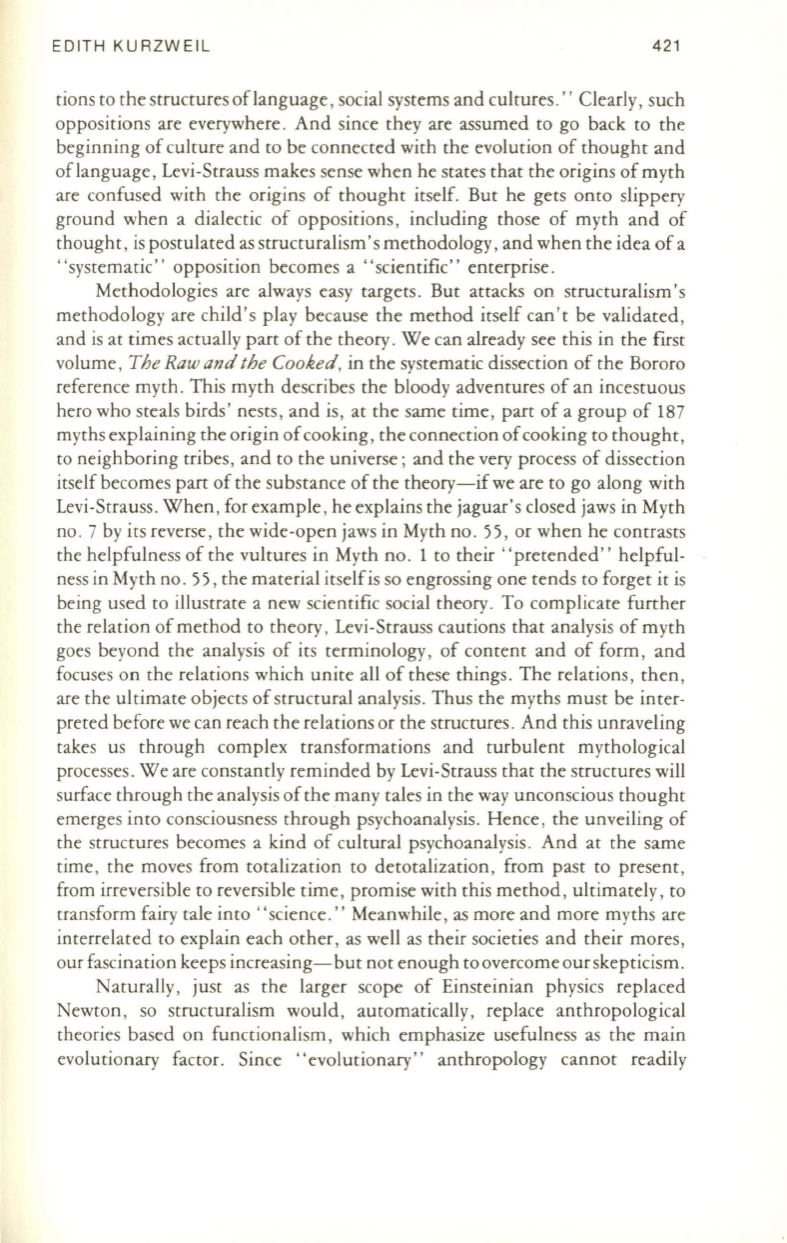
EDITH KURZWEIL
421
tions to the structures oflanguage, social systems and cultures ." Clearly , such
oppositions are everywhere. And since they are assumed to go back to the
beginning of culture and to be connected with the evolution of thought and
oflanguage , Levi-Strauss makes sense when he states that the origins of myth
are confused with the origins of thought itself. But he gets onto slippery
ground when a dialectic of oppositions, including those of myth and of
thought , is postulated as structuralism's methodology, and when the idea of a
" systematic" opposition becomes a "scientific" enterprise.
Methodologies are always easy targets . But attacks on structuralism's
methodology are child 's play because the method itself can't be validated ,
and is at times actually part of the theory . We can already see this in the first
volume ,
The Raw and the Cooked,
in the systematic dissection of the Bororo
reference myth. This myth describes the bloody adventures of an incestuous
hero who steals birds' nests , and is, at the same time, part of a group of 187
myths explaining the origin ofcooking, the connection ofcooking to thought,
to neighboring tribes, and to the universe ; and the very process of dissection
itself becomes part of the substance of the theory-if we are to go along with
Levi-Strauss. When , for example, he explains the jaguar's closed jaws in Myth
no. 7 by its reverse , the wide-open jaws in Myth no. 55, or when he contrasts
the helpfulness of the vultures in Myth no . 1 to their' 'pretended" helpful–
ness in Myth no. 55, the material itself is so engrossing one tends to forget it is
being used to illustrate a new scientific social theory. To complicate further
the relation of method to theory , Levi-Strauss cautions that analysis of myth
goes beyond the analysis of its terminology, of content and of form, and
focuses on the relations which unite all of these things. The relations , then ,
are the ultimate objects of structural analysis. Thus the myths must be inter–
preted before we can reach the relations or the sttuctures . And this unraveling
takes us through complex transformations and turbulent mythological
processes. We are constantly reminded by Levi-Strauss that the structures will
surface through the analysis of the many tales in the way unconscious thought
emerges into consciousness through psychoanalysis. Hence, the unveiling of
the structures becomes a kind of cultural psychoanalysis . And at the same
time , the moves from totalization to detotalization, from past to present ,
from irreversible to reversible time, promise with this method, ultimately, to
transform fairy tale into" science ." Meanwhile, as more and more myths are
interrelated to explain each other, as well as their societies and their mores,
our fascination keeps increasing-but not enough to overcome our skepticism .
Naturally, just as the larger scope of Einsteinian physics replaced
Newton, so structuralism would, automatically, replace anthropological
theories based on functionalism , which emphasize usefulness as the main
evolutionary factor. Since "evolutionary" anthropology cannot readily


